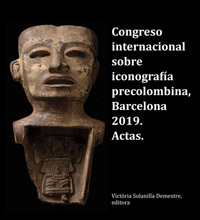Zea E-Books

Congreso internacional sobre iconografía precolombina, Barcelona, 2019. Actas.
Date of this Version
8-20-2020
Document Type
Article
Citation
Publicado en Congreso internacional sobre iconografía precolombina, Barcelona 2019. Actas, Victòria Solanilla Demestre, editora (Lincoln, Nebraska: Zea Books, 2020). https://doi.org/10.32873/unl.dc.zea.1254
Abstract
Las tumbas Mochica Medio de El Sacerdote Lechuza y La Sacerdotisa de San José de Moro (SJM) esbozan una identidad individual particular y relacionan a los individuos enterrados con una élite ceremonial en la que habrían desempeñado funciones de oficiantes adscritas a los rituales en los que dichos personajes aparecen en la iconografía. Por un lado, la tumba del Sacerdote Lechuza, llena de alusiones iconográficas a la lechuza (metales y cerámica) que remiten a la figura del Sacerdote Lechuza; por otro lado, la tumba de la Sacerdotisa, con varios elementos del “Tema de la Presentación” tallados en concha que ejercen obligatoriamente de antecedente a la tradición de Sacerdotisas enterradas en SJM en periodos posteriores.
The Middle Moche tombs of The Barn Owl Priest and The Priestess found in San Jose de Moro (SJM) outline a particular individual identity and link the buried individuals with a ceremonial elite in which they would have performed functions of officiants attached to the rituals in which these characters appear in the iconography. On one hand, the tomb of the Barn Owl Priest, full of iconographic allusions to the barn owl (metals and pottery) that refer to the figure of the Barn Owl Priest; on the other hand, the tomb of the Priestess, with several elements from the “Presentation Theme” carved in shell necessarily represent as a predecessor to the tradition of Priestesses buried in SJM in later periods.
Included in
American Material Culture Commons, Indigenous Studies Commons, Museum Studies Commons, Other History of Art, Architecture, and Archaeology Commons, Other Languages, Societies, and Cultures Commons


Comments
Copyright 2020 por la autora.